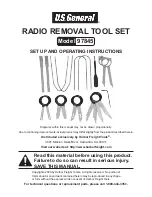
Wheels
Your Ford GT is equipped with unique wheels matched to the tires.
These wheels are more susceptible to damage due to their diameter,
width and low profile tires. To avoid damage to your wheels:
•
Maintain proper tire pressure (see “Tires” previously listed).
•
When installing wheels, always torque lug nuts to specification with a
torque wrench.
•
Inspect your wheels for damage on a regular basis. If a wheel is
damaged, replace it immediately.
•
In the event that you encounter an abnormally harsh impact, inspect
the outer diameter of your wheels, both inside and out, for damage
Operating a performance vehicle at higher than normal speeds
Your Ford GT is capable of operating at higher than normal speeds and is
equipped with tires rated for the vehicles’ maximum speed. However, it
is important to remember to always drive safely, obey all traffic laws and
only operate your Ford GT at higher than normal speeds at locations and
under conditions where such can be done safely. Also, before operating
your vehicle at higher than normal speeds:
•
Maintain your tire pressures according to the tire information and high
speed warning labels located on the B-pillar or the edge of the driver’s
door.
•
Inspect wheels and tires for wear and damage. Replace any damaged
wheels or tires.
Winter driving
The original equipment tires on your Ford GT are designed for maximum
performance in dry and wet conditions. They are not designed for winter
use on ice or snow and cannot be used with snow chains or other tire
mounted traction aids.
Tire and wheel alignment
A bad jolt from hitting a curb or pothole can cause the front end of your
vehicle to become misaligned or cause damage to your tires. If your
vehicle seems to pull to one side when you’re driving, the wheels may be
out of alignment. Have a qualified technician at a Ford or
Lincoln/Mercury dealer check the wheel alignment periodically.
200
6
GT
(gto)
Owners Guide (post-2002-fmt)
USA_English
(fus)
Tires, Wheels and Loading
87















































